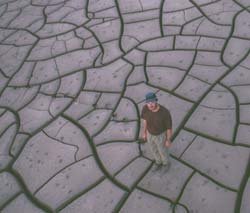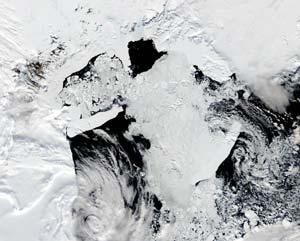For the second time in 26 months, a massive iceberg has clogged a large portion of Antarctica’s Ross Sea, causing what could turn out to be a devastating loss of penguins and other marine life, according to a NASA-funded study by Stanford scientists.
Using satellite data, geophysicists Kevin Arrigo and Gert L. van Dijken monitored the movements of a giant iceberg named “C-19,” which calved off the western face of the Ross Ice Shelf in May 2002. C-19 is one of the largest icebergs ever
Research reveals thriving oceanographic system
When the U.S. Dept. of Interior contracted with Florida Tech Oceanographer John Trefry to study the impact of recent offshore oil drilling in the Alaskan Arctic, the Florida Academy of Sciences gold medallist had some concerns about what he might discover. Instead of finding significant impacts, however, Trefry and his team of Florida Tech scientists were amazed by the discovery of a remarkable, thriving oceanographic system.
Du

Conventional wisdom says a river’s flood plain builds bit by bit, flood after flood, whenever the stream overflows its banks and deposits new sediment on the flood plain. But for some vast waterways in South America’s Amazon River basin, that wisdom doesn’t hold water, according to scientists funded by the National Science Foundation (NSF). Results of their research are published in the October 2nd issue of the journal Nature. Seasonal rains wash billions of tons of rock and s

NASA satellites observed the calving, or breaking off, of one of the largest icebergs ever recorded, named “C-19.”
C-19 separated from the western face of the Ross Ice Shelf in Antarctica in May 2002, splashed into the Ross Sea, and virtually eliminated a valuable food source for marine life. The event was unusual, because it was the second-largest iceberg to calve in the region in 26 months.
Over the last year, the path of C-19 inhibited the growth of minute, free-floating aquati
IBISCA’s push to understand insect habitats in the tropical forest
Of the 10 million plus species thought to exist on this planet, a mere 2 million are known to science. Others dwell in inaccessible locations–deep sea vents or hard-to-reach tropical treetops. To collect the best information available to date on tropical forest insects and their habitats, thirty researchers will use state-of-the-art canopy access techniques to sample nine 400m2 patches of Panamanian rainforest fr

As a paleontologist, Gerta Keller has studied many aspects of the history of life on Earth. But the question capturing her attention lately is one so basic it has passed the lips of generations of 6-year-olds: What killed the dinosaurs?
The answers she has been uncovering for the last decade have stirred an adult-sized debate that puts Keller at odds with many scientists who study the question. Keller, a professor in Princeton’s Department of Geosciences, is among a minority of scientists